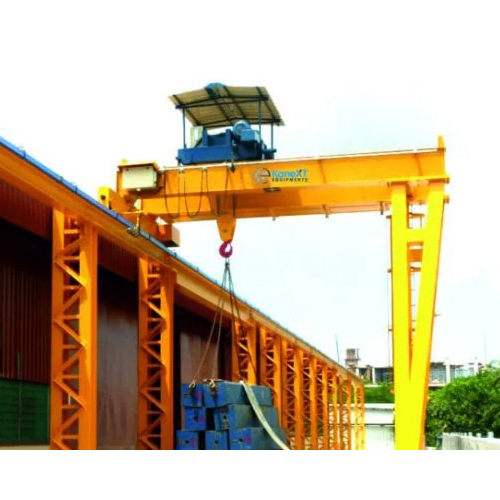Semi Goliath Crane, also known as a Semi Gantry Crane, is a unique type of lifting equipment that combines features of both an overhead traveling crane (EOT crane) and a full goliath (or gantry) crane. Its distinctive design makes it a versatile and space-saving solution for material handling in various industrial settings, both indoors and outdoors.
How it's Designed:
The key characteristic of a Semi Goliath Crane is its asymmetrical structure:
- One side (leg) runs on ground-level rails: Similar to a full gantry crane, one end of the bridge girder is supported by a vertical leg (or legs) that travels on rails installed on the floor.
- The other side runs on an elevated runway beam: The opposite end of the bridge girder is supported by an end carriage that travels on a traditional overhead runway beam, which is typically mounted on existing building columns or a dedicated elevated structure.
This hybrid design offers several advantages over a full EOT crane (which requires elevated runways across the entire span) or a full gantry crane (which requires ground rails across the entire span).
Key Features and Advantages:
- Space Optimization: Ideal for situations where a full gantry crane would take up too much floor space, or where a full overhead crane is not feasible due to existing building structures or limited support points. It effectively utilizes a portion of the workshop bay or outdoor area.
- Cost-Effective: Can be more economical than a full overhead crane as it eliminates the need for extensive overhead structural support across the entire width of the working area.
- Flexibility: Suitable for both indoor and outdoor applications. For outdoor use, it can leverage the existing building's exterior wall for one side of the runway.
- Customization: Can be designed with single or double girders, and customized for various load capacities, spans, lifting heights, and speeds to suit specific operational requirements.
- Efficient Material Handling: Provides efficient lifting and movement of heavy loads within its designated working area.
- Robust Construction: Built with high-strength steel and durable components to ensure reliable and long-lasting performance in demanding industrial environments.
- Safety Features: Equipped with standard safety mechanisms such as overload protection, limit switches, emergency stop buttons, and anti-collision systems.
Typical Specifications:
Specifications for Semi Goliath Cranes vary depending on the manufacturer and the specific application, but common parameters include:
- Safe Working Load (SWL): Ranges from 1 ton up to 100 tons or more, depending on single or double girder configuration and application.
- Span Length: Typically from 5 meters to 50 meters, or customized as per site.
- Height of Lift: Customizable, often up to 15 meters or more.
- Duty Class: Equivalent to M3, M5, M7, M8 as per IS (Indian Standard) or ISO standards, depending on the intensity of use.
- Lifting Speed: Standard and micro-speed options, often with variable frequency drives (VFDs) for precise control.
- Traversing Speed (Long Travel & Cross Travel): Customizable, with options for smooth acceleration and deceleration.
- Power Supply: Generally 3-phase, 415V, 50Hz (in India), with options for shrouded DSL (Down Shop Leader) bus bars or cable reeling drums for power feed.
- Control: Pendant push button control from the floor, and/or radio remote control.
- Design Standards: Manufactured as per IS 807, IS 3177, or equivalent international standards.
Applications:
Semi Goliath Cranes are widely used in industries where heavy lifting is required in specific zones or along one side of a facility:
- Manufacturing Units: For material handling in production lines, assembly shops, or near specific machinery where a full overhead crane isn't needed across the entire bay.
- Workshops and Fabrication Yards: Moving heavy components within a designated area.
- Warehouses and Logistics: Efficient storage and retrieval of goods in areas with height or space constraints.
- Railway Yards: For handling railway tracks, bogies, or other heavy railway components.
- Construction Sites: Lifting and moving building materials in a specific area.
- Outdoor Stockyards: For handling materials in open areas where one side can be supported by an existing structure.
- Shipyards: For specific material handling tasks along the length of a ship.

